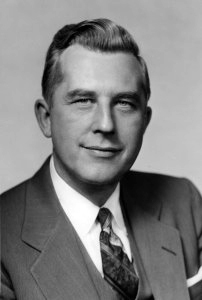Robert B. Meyner facts for kids
Quick facts for kids
Robert B. Meyner
|
|
|---|---|
 |
|
| 44th Governor of New Jersey | |
| In office January 19, 1954 – January 16, 1962 |
|
| Preceded by | Alfred E. Driscoll |
| Succeeded by | Richard J. Hughes |
| Member of the New Jersey Senate from Warren County |
|
| In office 1948–1952 |
|
| Succeeded by | Wayne Dumont |
| Personal details | |
| Born |
Robert Baumle Meyner
July 3, 1908 Easton, Pennsylvania, U.S. |
| Died | May 27, 1990 (aged 81) Captiva, Florida, U.S. |
| Political party | Democratic |
| Spouse |
Helen Stevenson
(m. 1957) |
| Alma mater | Lafayette College Columbia Law School |
Robert Baumle Meyner (July 3, 1908 – May 27, 1990) was an American politician. He was a member of the Democratic Party. Meyner served as the 44th governor of New Jersey from 1954 to 1962. Before becoming governor, he was a state senator for Warren County from 1948 to 1951.
Contents
Early Life and Education
Robert Meyner was born on July 3, 1908, in Easton, Pennsylvania. His parents were Gustave and Maria Meyner. In 1916, his family moved to Phillipsburg, New Jersey.
He went to Phillipsburg High School and graduated in 1926. After high school, Meyner attended Lafayette College. There, he studied government and law. He also worked as the editor of the student newspaper.
After college, he went to Columbia Law School. He earned his law degree in 1933. While in school, he worked different jobs, including as a weaver. After law school, he worked as a law clerk.
Political Career
In 1936, Meyner returned to Phillipsburg. He became a well-known lawyer there. During World War II, he served as an officer in the Navy. He left the Navy as a lieutenant commander.
New Jersey State Senate
Meyner first ran for the New Jersey Senate in 1941 but lost by a small number of votes. He was elected to the state senate in 1947. He became the leader of the minority party in 1950. However, he lost his senate seat in the 1952 election.
Governor of New Jersey
In 1953, the Democratic Party chose Meyner to run for governor. He won the election, which was a surprise to many. His first term as governor focused on improving state education. He also worked to reorganize the government.
During his time as governor, Meyner found issues with how money was being handled in a state division. He took action to fix these problems. In 1957, he was re-elected governor, easily defeating his opponent, Malcolm Forbes.
Meyner finished his second term in January 1962. At that time, New Jersey's rules did not allow governors to serve more than two terms in a row. He ran for governor again in 1969, but he lost to William T. Cahill.
Presidential Campaign
In 1958, Time Magazine thought Meyner might run for president. They even featured him on their magazine cover. At the 1960 Democratic National Convention, Meyner received some votes for president. He finished fifth among the candidates.
Later Life and Family
After leaving the governor's office, Meyner started a law firm in Newark, New Jersey.
He married Helen Stevenson Meyner on January 19, 1957. Helen Meyner later served in the U.S. House of Representatives.
Robert Meyner passed away on May 27, 1990, in Captiva, Florida.


